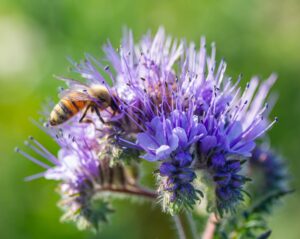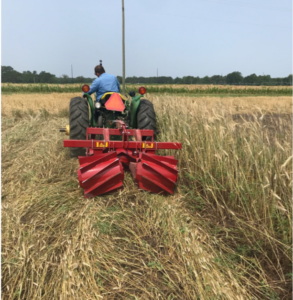July 16, 2020 – Editor’s Note: This blog post was originally published on the National Sustainable Agriculture Coalition’s (NSAC) website on July 10, 2020. OFRF is cross-posting relevant blog posts from this series covering provisions of the Agriculture Resilience Act (ARA) that impact or highlight organic agriculture’s role in addressing climate change. The ARA is the first comprehensive piece of legislation introduced in this Congress addressing climate change and agriculture.
Last week, the House Select Committee on the Climate Crisis released its highly anticipated report, outlining policy recommendations for Congress to implement for the U.S. to reach net-zero greenhouse gas emissions by 2050. The report included a chapter on agriculture, recognizing its critical role in our efforts to adapt to and mitigate climate change. Many of the provisions from the Agriculture Resilience Act (ARA), the most comprehensive piece of legislation addressing agriculture and climate change introduced in Congress, were included in the Select Committee’s report.
The ARA is made up of six building blocks that align well with the agriculture components highlighted in the Select Committee’s report: agricultural research, pasture-based livestock, soil health, farmland preservation, renewable energy, and food waste.
In this blog, we dig into the soil health provisions in the ARA, emphasizing the proposed changes to the country’s primary working lands conservation programs: the Environmental Quality Incentives Program (EQIP) and the Conservation Stewardship Program (CSP). Both the ARA and the Select Committee’s report call for increased funding and expansion of CSP and EQIP to increase climate mitigation and resilience in agriculture.
A major increase in support for working lands conservation programs is critical if the agriculture sector is to reach the goal of net zero by 2040 as outlined in the ARA. Federal policy and resources need to support the transition of agriculture from current production systems to more climate-friendly and resilient ways of farming, which requires a significant investment in existing conservation programs like CSP and EQIP.
Without increased investment and commitment to conservation agriculture by the federal government, farmers and ranchers will not have the tools and resources they need to meaningfully participate and contribute to climate change mitigation and adaptation efforts. The ARA outlines the changes and increased support conservation programs need for agriculture to fulfill its potential to mitigate climate change.
Climate-Focused Working Lands Conservation Programs
Environmental Quality Incentives Program
EQIP offers farmers and ranchers financial cost-share and technical assistance to implement conservation practices on working agricultural land. Farmers and ranchers participating in EQIP can install or implement structural, vegetative, and management practices – like improving irrigation efficiency, restoring pasture, or improving nutrient management.
The ARA would enhance EQIP’s ability to address climate change by adding greenhouse gas emissions reduction and carbon sequestration to the program’s purpose and listing both greenhouse gas emissions reduction and carbon sequestration in the top ten practices that can receive higher payment rates.
EQIP assistance is available through a general funding pool and also through special initiatives with separate funding that highlight specific practices or natural resources, such as the Organic Initiative (OI). Organic agriculture builds soil health and does not rely on energy-intensive chemical inputs, resulting in increased carbon storage and reduced greenhouse gas emissions. Increasing incentives for organic production and for transition to organic are critical investments needed for agriculture to fulfill its potential to mitigate climate change and to build more resilient farming systems.
For years, EQIP-OI has had a separate, lower payment limit than general EQIP, which has discouraged many organic producers and those wishing to transition to organic production from applying to the program. The ARA would eliminate the discriminatory lower organic payment limit, taking an important step to improving the program’s outcomes on soil health and resilience.
Within EQIP, 50 percent of national funding is set aside for livestock operations. The ARA would target at least two thirds of that 50 percent to advanced grazing management, including management-intensive rotational grazing which has a huge positive benefit for carbon sequestration in agricultural soils. The ARA would also limit EQIP funding available for concentrated animal feeding operations (CAFO) and their massive environmental and greenhouse gas footprint by mandating that any CAFO receiving EQIP funding must develop and implement a greenhouse gas emissions reduction plan.
Finally, the ARA would add greenhouse gas emissions reduction to the purposes of the Conservation Innovation Grants (CIG) focused on air quality and increase funding for air quality grants from the current $37.5 million to $50 million for each fiscal year starting in fiscal year 2021. The bill would also increase funding for CIG On-Farm Conservation Innovation Trials from the current $25 million to $50 million per year from fiscal year 2021 to 2023 and bump funding even more to $100 million starting in fiscal year 2024. If the ARA becomes law, overall EQIP funding would increase from a little over $2 billion in fiscal year 2023 to $3 billion in fiscal year 2024 and beyond. This increased investment would result in more farmers and ranchers being equipped to adapt to and mitigate climate change on their farms and ranches.
Conservation Stewardship Program
CSP recognizes and rewards farmers and ranchers for the critical role they play as managers of our shared air, water, and soil resources. Through CSP, farmers can earn payments for actively managing, maintaining, and expanding comprehensive conservation activities on their land. As the largest working lands conservation program in the country, CSP can play a vital role in enhancing agriculture’s potential to sequester carbon, reduce greenhouse gas emissions, and build resilience.
The ARA would add soil health enhancement and greenhouse gas emissions reduction to the ranking criteria for applicants hoping to participate in the program. CSP already supports both of those goals, but it is not explicitly recognized in the program’s purposes. The bill would also add climate adaptation and mitigation as a resource concern that farmers may address through their participation in the program, and it would close loopholes that have allowed large landowners to receive higher payments than the law permits. Additionally, the ARA would restore automatic renewals under CSP to allow for continual improvement in soil health and carbon sequestration and incorporate more farmers and more acres in this urgent mission.
The ARA would also create a new CSP On-Farm Conservation Stewardship Innovation Grant program. The CSP On-Farm Innovation Grants would support on-farm research and development and pilot testing of innovative conservation systems and enhancements to further the program’s climate mitigation and adaptation potential. The legislation would increase total CSP funding from $725 million in fiscal year 2020 to $2 billion in fiscal year 2021 and gradually increase funding up to $4 billion in fiscal year 2024 and beyond.
The funding cuts that were made to CSP in the 2014 and 2018 Farm Bills mean that farmers are increasingly struggling to obtain conservation assistance, signaling a weakening in our national commitment to conservation agriculture. Congress must bolster its commitment and investment to conservation agriculture, especially as the climate crisis continues to have devastating impacts on farmers, ranchers, and rural communities. We must support farmers as they adapt to climate change, and we must provide the tools and resources farmers need to be active leaders in our climate mitigation efforts.
Enhancing Program Implementation
The ARA makes several changes to enhance the way conservation programs are implemented, making it easier to engage farmers in good, climate-focused conservation practices. Among these enhancements are a set aside of one percent of total farm bill conservation program annual mandatory funding for a major, new conservation technical assistance initiative. This initiative, delivered by both the Natural Resources Conservation Service (NRCS) and by third parties, would assist producers in mitigating and adapting to climate change by providing farmers with an expert in the field from plan to planting.
The Select Committee’s report includes this provision from the ARA calling for increased support for the NRCS Conservation Technical Assistance program and increased technical assistance to farmers and ranchers to mitigate and adapt to climate change, as well as research and deployment of agricultural climate solutions. For a more complete summary of the Select Committee’s support for the ARA, see our blog on the report.
Finally, the ARA would also direct the U.S. Department of Agriculture (USDA) to adjust payment rates as necessary to accelerate progress toward the legislation’s bold goal of getting the United States agriculture sector to net-zero emissions by 2040.
Intersection Between Racial Equity and Climate Change Legislation
The COVID-19 pandemic has showcased the vulnerabilities of our food and farming systems and the disproportionate impact that environmental and economic shocks have on communities of color. Low-income communities and communities of color are more likely to be affected by extreme weather events, like flooding, due to the legacy of many public policies that have clustered vulnerable communities in damage-prone areas, such as floodplains.
The ARA takes an initial step to address inequities that farmers of color and beginning farmers face regarding climate change and agriculture. The bill would increase the set-aside for beginning and socially disadvantaged farmers and ranchers in both EQIP and CSP from a combined 10 percent of funding to a combined 30 percent of funding. While this is a small measure, it is a necessary one to ensure that farmers of color and beginning farmers, who often have the fewest resources and minimal capital, can access the tools they need to adapt to and to mitigate climate change on their farms.
The bill would also authorize USDA to provide incentives to help a new generation of farmers and ranchers to start using the full array of climate-friendly practices from the outset of their farming careers. Farmers and ranchers that start their farms centered around climate-focused practices will not only help us reach the goal of net-zero agriculture by 2040 but maintain that benchmark for decades afterward.
What Comes Next
The ARA and the Select Committee’s recent report provide a roadmap for legislative efforts to address the climate crisis. A major investment and commitment to working lands conservation programs is necessary for agriculture to fulfill its potential to mitigate the effects of the climate crisis.
Now that the Select Committee has released its report, containing many of the ARA provisions, NSAC and OFRF encourage everyone to reach out to their Representative to co-sponsor and support Congresswoman Pingree’s Agriculture Resilience Act. The bill provides the necessary resources to support agricultural solutions that reduce emissions and create resilient food and farming systems.
NSAC and OFRF encourage Congress to use the ARA and the Select Committee’s report to think differently about federal farm programs and reconsider how they can better support climate-resilient conservation farming. Their action now is vital to begin the pivot from our current federal policy which fosters and subsidizes overproduction, specialization, and consolidation that inevitably lead to greater climate disruption. Instead, legislators should build a new agricultural policy that ensures farmers have a central role to play in climate mitigation and adaptation. Farmers want to be better stewards and the public supports them, so Congress should do what is right and give farmers the policies, tools, and resources that they need to address the climate crisis.
You can read the full text of the Agriculture Resilience Act here and the Select Committee Report here.
Photo credit: Katherine Belk, Wild Hope Farm
 September 30, 2020–OFRF is pleased to share the news that our board member, Dr. Carolyn Dimitri, an Associate Professor of Food Studies at New York University, has been appointed to the National Organic Standards Board (NOSB). The NOSB is made up of 15 volunteer members representing the organic community. Carolyn and the four other new members will serve five-year terms beginning in January 2021. Read the USDA’s announcement to learn more.
September 30, 2020–OFRF is pleased to share the news that our board member, Dr. Carolyn Dimitri, an Associate Professor of Food Studies at New York University, has been appointed to the National Organic Standards Board (NOSB). The NOSB is made up of 15 volunteer members representing the organic community. Carolyn and the four other new members will serve five-year terms beginning in January 2021. Read the USDA’s announcement to learn more.



 August 26, 2020 – OFRF’s free beginning farmer training program for organic specialty crop farmers in California is now available. This online training program is for beginning farmers, existing organic farmers, and farmers in transition to organic production. While it was developed for California specialty crop farmers, the content is based on foundational principles that are relevant to all organic farmers and our hope is that growers across the U.S. find it to be a useful resource. The self-guided nature of the training program allows you to move through the readings and resources, visual and written content, and demonstration videos at your own pace.
August 26, 2020 – OFRF’s free beginning farmer training program for organic specialty crop farmers in California is now available. This online training program is for beginning farmers, existing organic farmers, and farmers in transition to organic production. While it was developed for California specialty crop farmers, the content is based on foundational principles that are relevant to all organic farmers and our hope is that growers across the U.S. find it to be a useful resource. The self-guided nature of the training program allows you to move through the readings and resources, visual and written content, and demonstration videos at your own pace. Balancing soil health and weed management is a serious challenge for organic producers. Tillage is an effective method of controlling weeds, but is energy intensive and can degrade soil health. Cover cropping is an alternative practice that can suppress weeds and build soil health. However, when to terminate cover crops is not straightforward. Terminating cover crops using a roller crimper—a piece of equipment that gently pushes the cover crop residue over the soil surface—has been shown to effectively suppress weeds in row-crops such as soybean, but less is known about the efficacy of roller-crimped cover crops in vegetable production. In 2019, OFRF provided a grant to Professor Alex Woodley at North Carolina State University to begin addressing this question in sweet potatoes, an economically important crop in North Carolina.
Balancing soil health and weed management is a serious challenge for organic producers. Tillage is an effective method of controlling weeds, but is energy intensive and can degrade soil health. Cover cropping is an alternative practice that can suppress weeds and build soil health. However, when to terminate cover crops is not straightforward. Terminating cover crops using a roller crimper—a piece of equipment that gently pushes the cover crop residue over the soil surface—has been shown to effectively suppress weeds in row-crops such as soybean, but less is known about the efficacy of roller-crimped cover crops in vegetable production. In 2019, OFRF provided a grant to Professor Alex Woodley at North Carolina State University to begin addressing this question in sweet potatoes, an economically important crop in North Carolina. August 6, 2020 – Earlier this year, OFRF released a
August 6, 2020 – Earlier this year, OFRF released a  August 4, 2020 – The Organic Farming Research Foundation (OFRF) and
August 4, 2020 – The Organic Farming Research Foundation (OFRF) and